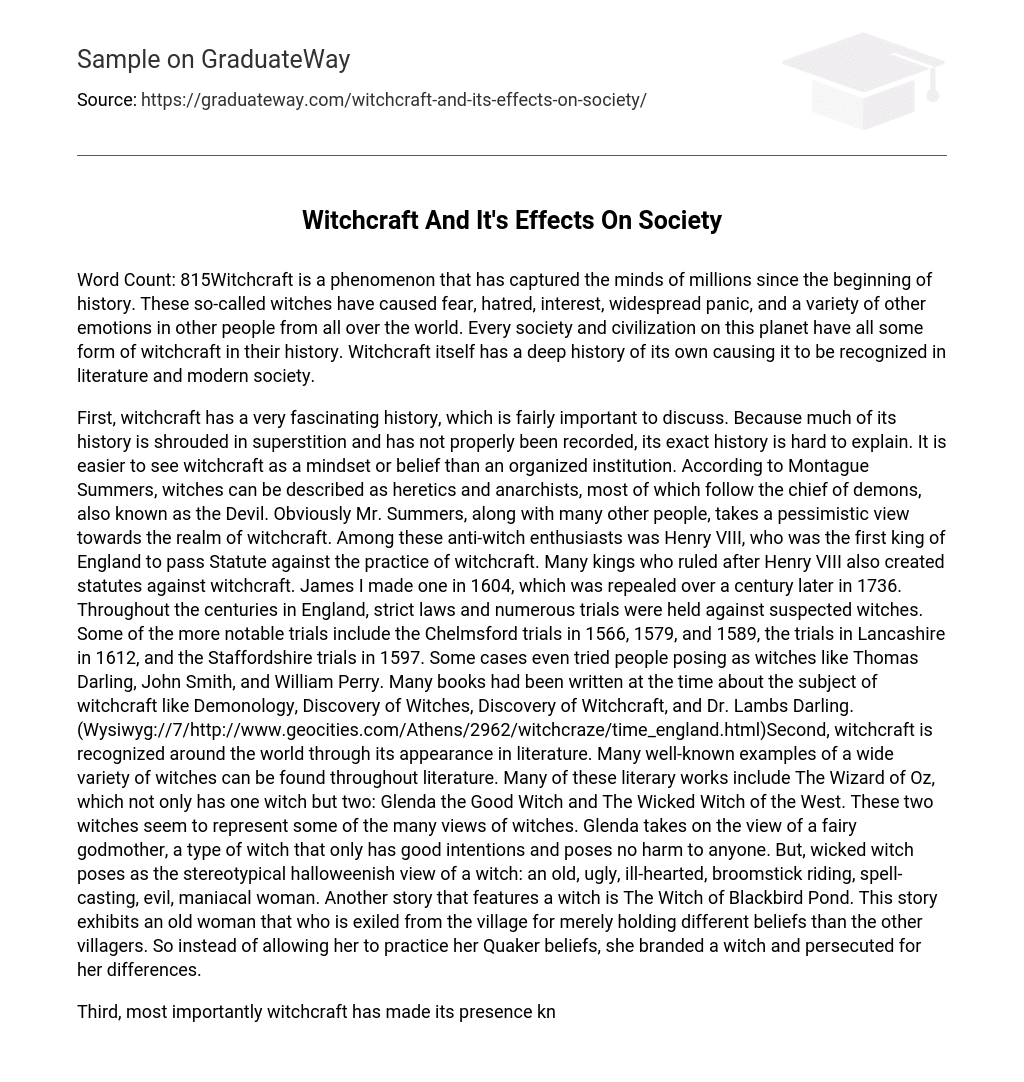Word Count: 815Witchcraft is a phenomenon that has captured the minds of millions since the beginning of history. These so-called witches have caused fear, hatred, interest, widespread panic, and a variety of other emotions in other people from all over the world. Every society and civilization on this planet have all some form of witchcraft in their history. Witchcraft itself has a deep history of its own causing it to be recognized in literature and modern society.
First, witchcraft has a very fascinating history, which is fairly important to discuss. Because much of its history is shrouded in superstition and has not properly been recorded, its exact history is hard to explain. It is easier to see witchcraft as a mindset or belief than an organized institution. According to Montague Summers, witches can be described as heretics and anarchists, most of which follow the chief of demons, also known as the Devil. Obviously Mr. Summers, along with many other people, takes a pessimistic view towards the realm of witchcraft. Among these anti-witch enthusiasts was Henry VIII, who was the first king of England to pass Statute against the practice of witchcraft. Many kings who ruled after Henry VIII also created statutes against witchcraft. James I made one in 1604, which was repealed over a century later in 1736. Throughout the centuries in England, strict laws and numerous trials were held against suspected witches. Some of the more notable trials include the Chelmsford trials in 1566, 1579, and 1589, the trials in Lancashire in 1612, and the Staffordshire trials in 1597. Some cases even tried people posing as witches like Thomas Darling, John Smith, and William Perry. Many books had been written at the time about the subject of witchcraft like Demonology, Discovery of Witches, Discovery of Witchcraft, and Dr. Lambs Darling. (Wysiwyg://7/http://www.geocities.com/Athens/2962/witchcraze/time_england.html)Second, witchcraft is recognized around the world through its appearance in literature. Many well-known examples of a wide variety of witches can be found throughout literature. Many of these literary works include The Wizard of Oz, which not only has one witch but two: Glenda the Good Witch and The Wicked Witch of the West. These two witches seem to represent some of the many views of witches. Glenda takes on the view of a fairy godmother, a type of witch that only has good intentions and poses no harm to anyone. But, wicked witch poses as the stereotypical halloweenish view of a witch: an old, ugly, ill-hearted, broomstick riding, spell-casting, evil, maniacal woman. Another story that features a witch is The Witch of Blackbird Pond. This story exhibits an old woman that who is exiled from the village for merely holding different beliefs than the other villagers. So instead of allowing her to practice her Quaker beliefs, she branded a witch and persecuted for her differences.
Third, most importantly witchcraft has made its presence known through its appearance in American popular culture. Namely, it has become the subject of numerous television programs. Since the early 1960s there have been almost a dozen network television programs based on the lives of witches. These shows include many popular hits like Bewitched, Angelique, Tabitha, Tuckers Witch, Free Spirit, Sabrina the Teenage Witch, and Charmed. Of these few programs, the most popular witches include Samantha (Elizabeth Montgomery) from Bewitched and Sabrina (Melissa Joan Hart) from Sabrina the Teenage Witch. Samantha always portrayed a caring, good witch that must keep her true identity hidden from everyone but her husband, Darrin. On the other hand, Sabrina is a bewildered teenager trying to cope with her newfound powers and the everyday problems of being a teenager. Witches have also appeared in numerous childrens programming that sets in at an early age the stereotypical view of witches. Some of these shows include Casper the Friendly Ghost, H.R. Pufnstuf, Sabrina the Teenage Witch, and The Bugaloos (Weeks, 23-25).
In conclusion, witches, in all their forms, have played an important role in the world, as we know it. They have caused such things as literature, culture, and society all a little more interesting by creating fear and curiosity. But, more often than not those who are different from everyone else are regarded as witches and not even treated with proper dignity. Possibly in the future people will reach a greater understanding of the so-called witches in society and become more aware of those who are different from them.
Works CitedSummers, Montague. The History of Witchcraft and Demonology. Dorset Press, New York. 1987.
Weeks, Janet. Charmed Life. TV Guide. Vol. 46, No. 50, Issue #2385. News America Publications Inc., Radnor. Dec. 12, 1999.
Van der Linde, Laurel. The Devil in Salem Village: The Story of the Salem. Witchcraft Trials. The Millbrook Press, Brookfield.1992.
Zeinert, Karen. The Salem Witchcraft Trials. Franklin Watts, New York.1989Wysiwyg://7/http://www.geocities.com/Athens/2962/witchcraze/time_england.html





